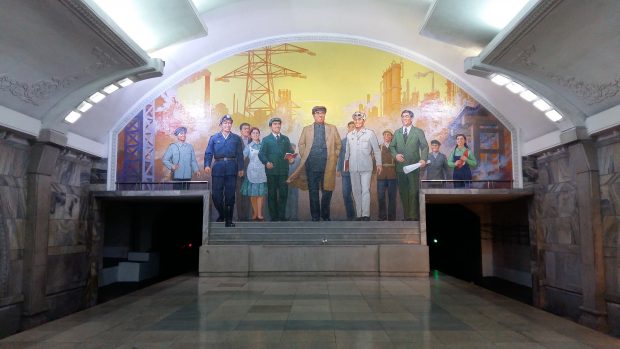My trip to Pyongyang: Finding South Korea there
Part I
As the shaky Antonov An-148 aircraft descended, it was nothing but North Korea below us, or so I thought. With the plane trundling up to the terminal at Pyongyang Sunan International Airport, I glanced out of the window to see the Taegukgi ― South Korea’s national flag. It was painted on the side of a massive 747 awaiting its VIP passenger, President Moon Jae-in, who was there for a three-day summit with North Korean leader Kim Jong-un. On Sept. 18, I flew to Shenyang, China, to travel to the North on Sept. 19. I went strictly as a tourist, not an undercover journalist. I chose the dates right and ended up overlapping my visit with the latest inter-Korean summit.
I visited North Korea during a moment in history unlike any other in the past. Sure, previous Presidents Kim Dae-jung and Roh Moo-hyun also visited, but that was Kim Jong-il’s North Korea. The North Korea of today is more globally minded, having had significantly more contact with foreign visitors, and it has a bit more swagger, knowing its nuclear arsenal frightens the Americans. As our bus drove through Pyongyang, I was once again struck by how colorful the architecture was, especially in comparison to drab Seoul, where gray and brown are the color palette of apartment complexes. And newer buildings, some which were construction sites on my last visit, looked like they were straight out of Las Vegas. Of course, one can’t judge the nationwide progress by Pyongyang alone, just like how one couldn’t look at Seoul and draw conclusions about the residents of North Gyeongsang Province. Before my visit, one of my colleagues put the idea in my head that perhaps the sanctions against North Korea have had unintended effects: now that North Korean goods and resources are embargoed, they are consumed domestically. That means more coal for electricity and industry. Certainly I never experienced a blackout and I saw more smoke-producing factories than last time. A few Koreans I mentioned this to agreed. We had to pull over once as a “traffic safety” car with flashing red-and-blue lights shot by, followed by a black car with tinted windows and two mini-buses. South Koreans.
Unfortunately, due to President’ Moon’s entourage, I was told we wouldn’t be staying at the Koryo Hotel, instead downgraded to the Yanggakdo Hotel sequestered on an island in the Taedong River. That convoy was our last South Korean sighting; even on a visit to the Joint Security Area (JSA) in Panmunjeom we didn’t see a single living soul on the other side. On my previous visit in 2010, we met South Korean priest Han Sang-ryeol staying at the Yanggakdo, just a day before he returned to the South dramatically by stepping over the military demarcation line (MDL) at the JSA. This time, all the South Koreans here in Pyongyang would go home peacefully and freely.
Throughout my four-day stay we were kept in the loop on the ongoing summit mainly by images on muted TVs. My hotel room TV carried Al Jazeera, which had regular coverage in its rotation, amid Chinese and North Korean channels. But I didn’t know what conversations were happening in the outside world. One travel companion with a smartphone could pull up internet coverage, even checking Twitter, which is how we first heard about Moon and Kim’s visit to Mount Paektu. We had also heard that President Moon had made an appearance at the Mass Games the night of our arrival, giving an impassioned speech before tens of thousands of North Korean performers and foreign tourists. But when we attended two days later on Friday, little did we know he had left a lasting impression on the record-breaking performance. Toward the end of the program, the Rungrado 1st of May Stadium _ the world’s largest _ went completely dark. Opposite us, over 30,000 schoolchildren held up blank placards, and on that was broadcast footage of Kim Jong-un and Moon Jae-in meeting at the JSA in April, shaking hands over the MDL. Following this were images from later summits.
The message was clear. After this, the orchestra performed foreign tunes, including “Libiamo ne’ lieti calici” from Verdi’s opera “La Traviata” and the Cuban song “Guantanamera,” to which the Venezuelan tourist next to me sang along. Meanwhile, those masses of schoolchildren held up placards reading “For Global Independence,” “Multilateral Foreign Relations,” “Solidarity, Cooperation, Good Neighborliness, Friendship,” “Independence, Peace, Friendship.”Through this all, North Koreans were talking, undeniably. One of our guides expressed appreciation for U.S. President Donald Trump, whose intentions toward Korea he saw as positive. We had this conversation in an out-of-the-way spot on the side of Mansu Hill between the statues of Kim Il-sung and Kim Jong-il and the statue of Chollima. Our guide held the handles of a wheelchair of one of our fellow travelers while he spoke of Juche as a philosophy of self-empowerment, and North Korea as post-communist. He referred to calls for permanent, verifiable, irreversible disarmament (PVID) as “bullxxxx,” a curse word he deployed with frankness and kindness in his voice.
He also criticized the U.S.-led U.N. Command blocking a South Korean inspection of North Korea’s rail infrastructure in August, a move that played right into the narrative that South Korea is a puppet state occupied by the U.S., or “America-occupied Korea” as one European traveler I encountered kept calling it. Days later, I took the same railway up to China, where I flew back to South Korea. The rail infrastructure up there seemed serviceable, but the inter-city roads were atrocious, and vehicles traveling up to 60 km/h get very shaky. Moon’s role on this trip was to act as a mediator between North Korea and the U.S., and in that mission he appears successful. This will be a long, sometimes frustrating process, and we’re probably closer to the start than the finish.
By Jon Dunbar
(Korea Times)






















































